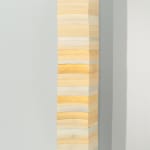-
Artworks
Manish Nai India, b. 1980
Untitled, 2019Old books and wood91 x 10 x 7 in
231.1 x 25.4 x 17.8 cm7177Further images
-
(View a larger image of thumbnail 1
)

-
(View a larger image of thumbnail 2
)

-
(View a larger image of thumbnail 3
)

-
(View a larger image of thumbnail 4
)

-
(View a larger image of thumbnail 5
)

-
(View a larger image of thumbnail 6
)

-
(View a larger image of thumbnail 7
)

-
(View a larger image of thumbnail 8
)

Using materials that are both modest and quintessentially Indian, like jute, teak and newspaper, Nai’s pieces are studies in tedious complexities that, once completed, are presented as a tightly organized...Using materials that are both modest and quintessentially Indian, like jute, teak and newspaper, Nai’s pieces are studies in tedious complexities that, once completed, are presented as a tightly organized unit. The media that Nai uses are usually cheap and ubiquitous, alluding to both hierarchies of artistic media and Indian social structures.
Nai’s book sculptures mobilize words as raw material for compacted objects, with the aesthetic inquiry: what is a book that cannot be read, or a sculpture that can’t fully be seen?
His iconic vision for socially-conscious minimalism has earned Nai global attention as a crucial voice for Indian art today. Paying mind towards the complex intersections of material culture, art history, class relations, and autobiography, his geometrically simple forms distill the essence of contemporary Mumbai. His book sculptures expand upon Nai’s ongoing meditation on time itself, as compressed layers of paper settle into distinct strata like sedimentary rock. The sequencing of the innumerable pages and subtle tonal shifts as distinct layers brings a new kind of clarity to the substance. In the case of the stacked book towers, while the forms are cleaner and more minimal than ever before, the contents remain elusive, refusing access to their text. Their history as books immediately accessible, but their content as text is arrested in time, frozen inside the sculpture. The small compressed books are slightly more generous with their covers readable, serving both as pedestals for their former contents, now twisted into gnarled knots, and clues to the content within. Meanwhile, text from the books gives brief flickers of legibility, but the organic forms twist and turn away from inquisitive eyes.
Artist Biography:
Manish Nai was born in 1980 in Gujarat, India. He holds a Diploma in Drawing and Painting from the L.S. Raheja School of Art in Mumbai. Nai’s position – rooted in the treatment of materials that come from his immediate surroundings and environment – has emerged as one of the most unique and promising positions in art of the Indian subcontinent. His work has been shown in group exhibitions at the Kasturbhai Lalbhai Museum, Ahmadabad (2019), tthe NTU Centre for Contemporary Art, Singapore (2018), the Smart Museum of Art, Chicago (2018), and the Dr. Bhau Daji Lad Museum, Mumbai (2018). He has participated in the 2nd edition of the Kochi-Muziris Biennale, Kerala (2014) and The Sculpture Park at Madhavendra Palace, Rajasthan (2017-18). Solo exhibitions of his work have been held at the Fondation Fernet Branca, St. Louis, France (2017) and Het Noordbrabants Museum, Den Bosch, The Netherlands (2018). He lives and works in Mumbai.Exhibitions
2019 Manish Nai, Kavi Gupta Gallery, Chicago, IL1of 4 -
(View a larger image of thumbnail 1
)







